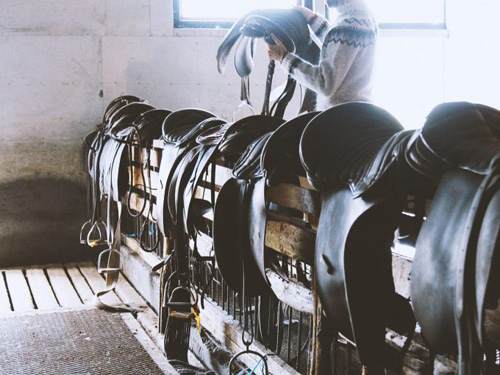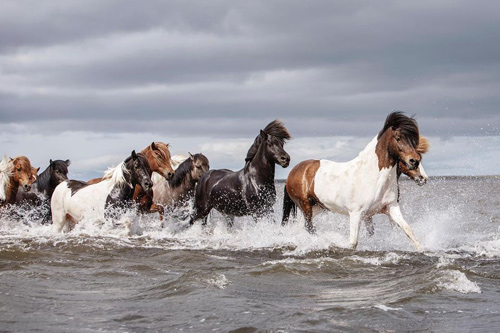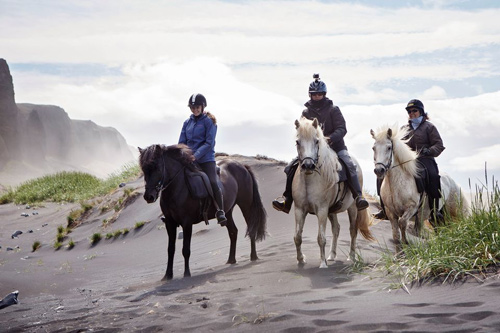Trail of Hope
Iceland Shorts Iceland: (IT-ICRT18)
URL: https://www.hiddentrails.com/tour/iceland_trail_hope_is.aspx
Introduction
Iceland Shorts
Iceland
This tour is an ideal opportunity for anyone wanting to enjoy a comfortable ride in a variety of landscapes. As we ride through unspoiled nature our guide introduces us to Iceland´s heroic past with tales of bloody conflict, revenge and love from the ancient Sagas.
Cantering along seemingly endless sandy stretches with the sea air in one´s face is an exhilarating experience for both rider and mount. There´s plenty of time to try the horse´s unique gait known as “tölt” while enjoying nature and learning something of the rich history of this beautiful and remote area.
We start the ride at Hvammur Farm in Vatnsdalur valley. Sense the adrenaline kick as we ride across the waters of Lake Hóp, driving a herd of free-running horses ahead of us. A visit to a seal colony on the North-Atlantic coast is something you don´t want to miss.
Accomodation
Accommodations
This is a stationary ride so all nights are spent at the same location.
Description
You will be accommodated at Hvammur Farm, in the beautiful Vatnsdalur Valley. The farmhouse was renovated 4 years ago and has a hot tub in the garden with a view over the river. There are 6 dormitory style bedrooms (2-4 beds per room) that can accommodate up to 20 guests. Facilities are shared and include 3 washrooms and 3 showers. There is no Wi-Fi connection but cellphone coverage is usually available.
Room Occupancy
Single room are not available on this trip.
Meals
During the ride full board is provided.
The menu consists of a large breakfast and traditional Icelandic meals (fish or lamb).
All riders make their own packed lunch from the breakfast table.
Dietary Restrictions
Vegetarian meals are available if requested in advance.
This trip includes
and can accommodate special dietary requests.
Riding

Riding Experience
This tour is a great riding experience that is suitable for strong intermediate-advanced riders. You need to be comfortable and in control at all paces, have a firm seat, and feel comfortable riding for up to 7 hours per day. Riders are expected to ride regularly and be capable of handling horses in an open country. Riding days can be as long as up to 35 km in the saddle so you should be in good physical condition and have a basic knowledge of horsemanship. You will get a thorough introduction into the gaits of the Icelandic horse and feel the Tölt, the extremely soft traveling gate of the Icelandic horse.
Riding Gear – Disinfect!
Riding gear (riding trousers, jackets, etc.) needs to be washed (40°C) or dry cleaned. Items which cannot be washed or dry cleaned (riding boots, riding hats) need to disinfected at least 5 days prior to arriving in Iceland. The Icelandic Veterinary Authority recommends the broad-spectrum disinfectant Virkon S for disinfection. Used riding gloves, whips, saddles, bridles, chaps and other used leather gear may not be brought into the country.
Please understand that these precautions are necessary because there are no contagious animal diseases in Iceland. Horses are not vaccinated and are therefore susceptible to infectious agents from abroad. Please help us to protect Iceland’s fragile nature!
We provide saddle bags, rain wear and safety helmet.
Tack & Riding Style
The tack used for Icelandic horses is slightly different then the tack ordinarily used for other breeds.
The saddle is built close to a dressage saddle and has a relatively flat seat. Saddles come with plain or quilted seats. On longer rides, a crupper helps keeping the saddle in place. Riding style used on Icelandic horses is close to English riding style, but stirrups are worn long.
Bits used are mostly simple snaffles. Bridles have a detachable noseband and clip on reins.
The Farmers
The real connoisseurs of the local terrain and history. We make sure that each tour has its own charm and is organized by the local expert, the farmer, and his family. They use their own horses and ride through the part of the country they know so well.
Our farmers have over 30 years of experience in leading riding groups through Iceland.
Herd of Horses
On this ride, you will be riding several days (except for two days) with a free running herd of horses. Herding along free running horses is the traditional way of travelling in Iceland, since horses are changed at least once a day on longer tours. You get to ride a variety of horses.
Horses
The Icelandic horse is best known for its four-beat smooth gait, the “tölt”, which is very comfortable for the rider, especially on a longer tour. Riding an Icelandic horse in its native habitat land is an authentic riding experience. The horses are especially chosen for this trip and are suited even for riders who have not had much riding experience.

Itinerary

Sample Itinerary - subject to changes
Day 1: Arrival & Introductory Ride
Pick up at 08:30 in the morning from the BSI Bus Station. Please be ready at the earliest pick up time and be dressed in your riding clothes. Transfer by bus from Reykjavík to Hvammur Farm, where we meet horses and guides.
We start our ride through Vatnsdalur Valley. This beautiful valley is the setting of the Vatnsdæla-Saga. We ride along the banks of River Vatnsdalsá before crossing over to the western side of the valley. Our ride ends at Sveinsstaðir Farm (the horses stay there overnight) and we return to Hvammur Farm for our overnight stay.
Riding approx. 14 km
Meals included: Lunch & Dinner
Overnight at Hvammur Farm
Day 2: Sveinsstaðir to Þverárétt
We leave Sveinsstaðir Farm and ride alongside the lagoon Hóp. The black sand at the beach is ideal for the special gait of the Icleandic horse. This trail along the shore gives us an idea of the beautiful lagoon we are going to cross tomorrow. We ride along the banks of Víðidalsá River and cross over it. We take a break at Stóra-Borg where our lunch break is and drive to Borgarvirki, a fascinating fortress from the Viking ages. Then we continue our ride to the sheep pen Þverárétt. It is used by local farmers to sort the sheep in the autumn.
Before returning to the guesthouse, we take another excursion to the shore where we see Hvítserkur, a basalt rock formation, nesting place to many seabirds. This area is home to large numbers of seals and hopefully we see many of them resting and playing on the beach.
Riding approx. 30 km
Meals included: Breakfast, Lunch & Dinner
Overnight at Hvammur Farm
Day 3: Ride to Thingeyrar Farm
Today, we explore the beauty of the Vatnsnes peninsula and follow black dunes on Sigríðarstaðasandur towards the North-Atlantic. We have our lunch brake on top of the ridge Nesbjörg where we enjoy the great view. Today we cross the lagoon Lake Hóp and follow a save trail through the water on our way to Thingeyrar Farm, once the site of a monastery founded in the 12th century. For sure this day is one of the highlights of this ride. Relax in the outdoor hot tub at Hvammur Farm before a hearty dinner.
Riding approx. 40 km
Meals included: Breakfast, Lunch & Dinner
Overnight at Hvammur Farm
Day 4: Thingeyrar Farm to Hvammur Farm
We start the day with a visit to historic Thingeyrar Church. This is our last day of riding and we bring the horses back to Hvammur Farm. We cross Lake Húnavatn on a safe trail in the water and enjoy the excitement of the horses once they have returned to the black sand on dry land. We ride on the eastern side of Vatnsdalur valley, past Hvammsfoss waterfall, surrounded by impressive basalt columns. Celebrate the successful return in the evening with a farewell dinner.
Riding approx. 25 km
Meals included: Breakfast, Lunch & Dinner
Overnight at Hvammur Farm
Day 5: Departure
It is time to say good bye to our guides and we drive on the scheduled bus over Kjölur Highland Road back to Reykjavík. Return to Reykjavik at approx. 12:30pm.
Meals included: Breakfast

Rates and Dates for Trail of Hope
Rates include:
Accommodations, All meals, Transfers from/to Reykjavik city center & 4 riding days
Rain wear, Water bottle, Saddle bag & Riding helmet can be provide
* prices are per person based on double/twin occupancy
Transfer and Other Charges:
|
2020
|
Pick up at BSÍ Bus station or at Reykjavik official bus stops near your accommodation between 7:30am-8:30am on Day 1
|
|
2020
|
Children's discount (under 12) - 25% off
|
Dates Note:
Sunday-Thursday
Rates do not include:
Alcoholic beverages (can be bought at Duty Free ahead of time) & Gratuities
Other Info
Meeting: Reykjavik
Airport: Keflavik Airport
Transfer: Reykjavik
Climate:
Blönduós area
|
Month
|
Jan
|
Feb
|
Mar
|
Apr
|
May
|
Jun
|
Jul
|
Aug
|
Sep
|
Oct
|
Nov
|
Dec
|
|
Average High Temperature (°F)
|
34
|
34
|
35
|
40
|
46
|
52
|
55
|
55
|
50
|
42
|
37
|
35
|
|
Average Low Temperature (°F)
|
23
|
23
|
24
|
29
|
36
|
41
|
45
|
45
|
39
|
33
|
27
|
24
|
|
Average High Temperature (°C)
|
1
|
1
|
2
|
4
|
8
|
11
|
13
|
13
|
10
|
6
|
3
|
2
|
|
Average Low Temperature (°C)
|
-5
|
-5
|
-4
|
-2
|
2
|
5
|
7
|
7
|
4
|
0
|
-3
|
-5
|
Source: NOAA
Seasons
As its name suggests, Iceland is cold, but not as cold as might be expected; thanks to the passing warm waters of the Gulf Stream, which regulate the climate. Its average mid-winter temperatures are no lower than those in New York City. The city's coastal location does, however, also mean it is prone to wind, and gales are common in winter. Reykjavik is also a very wet city, having on average 213 rainy days out of the year, with spring having slightly more sunny days! The south is the wettest part of the country. Coastal areas tend to experience winter gales and are generally windy.
Icelandic weather is known to be unpredictable and changing several times a day. A beautiful day can suddenly turn windy and rainy (and vice versa). Travelers to Iceland should be prepared for anything and dress in layers.
Winter
The average January temperature is 23°F (-5°C). From mid-November until the end of January, in the darkness of winter, the country only experiences a few hours of daylight each day.
Summer
The summer temperatures range from 29°F (4°C) at night to as high as 77°F (25°C) during the day. During the summer months there is almost continuous daylight; early spring and late autumn feature long twilights.
The Northern Lights are often visible in autumn and early winter.
What To Bring:
You should be ready for all kinds of weather as it can change very quickly.
We provide you with good rain-clothes, a riding helmet and a saddle bag (where you can keep the picnic lunch, a small camera, extra pair of gloves etc.).
Bring bags rather than hard cover suitcases. Pack light because transport space is limited.
Knee-high rubber boots are recommended for the beach ride!
You should be ready for all kinds of weather as the weather can change very quickly.
We recommend that the following items are included when preparing for our longer tours.
• Knee high riding boots - water resistant/ waterproof
• Warm jacket or overcoat.
• Warm (woolen or fleece) sweater.
• Warm socks and gloves, at least two pairs, scarf and a cap or hat.
• Warm underwear, long if possible (protects also against chafing).
• For the ladies – sports bra.
• Riding trousers.
• Track suit.
• A pair of slippers to wear in the accommodation (Icelanders take off their shoes when entering a house).
• Swim suits, towels, soap etc.
• A small camera to take with you on the ride.
• Band aids and second skin plasters for chaffing.
• Insect repellent, gnat net head cover.
• Chocolate or glucose sweets for strenuous riding days.
• Sun lotion for face and lips (with high sun factor).
• Sunglasses.
• For those with sensitive eyes/contact lenses, goggles.
• Ear plugs. Some people snore!
Disinfecting of the riding gear
It is important to follow the regulation regarding the disinfecting of used riding clothes. Riding gear (riding trousers, jackets, etc.) needs to be washed (40°C) or dry cleaned. Items which can not be washed or dry cleaned (riding boots, riding hats) need to be disinfected at least five days prior to arriving in Iceland. The Icelandic Veterinary Authority recommends the broad-spectrum disinfectant Virkon S for disinfection. Used riding gloves, whips, saddles, bridles and other used leather gear may not be brought into the country.
Please understand that these precautions are necessary because there are no contagious animal diseases in Iceland. Horses are not vaccinated and are therefore susceptible to infectious agents from abroad. Please help us to protect Iceland's fragile nature! For further information please take a look at: http://www.mast.is/english/frontpage/import-export/import/ridingequipment/
Cameras:
We recommend to bring a small camera that can be taken in a pocket, a waist/hip bag or in the saddle bag.
Large camera equipment we can not allow on the horses for security reasons. Tours are operated with a free running herd - at speed of tölt or trot for most of the day. We take breaks to relax the horses and then it is possible to take pictures. While on the horse taking pictures is rather difficult since the horses are constantly moving. Because of the herd instinct it is not possible to stop an individual horse, they all will follow each other.
You can leave larger Digital SLR with your luggage at the farm or put it in their luggage that will be transferred to the new accommodation.
|
|